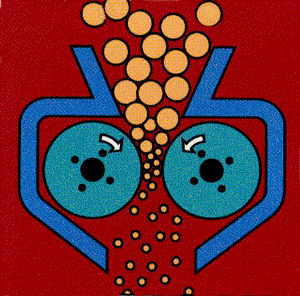Difference between revisions of "Rotary Crushers"
(Created page with "Category:Particle Size Reduction{{Knoppen}} <noinclude><!------------------------------------------------ * READ THIS FIRST * Only edit this page if you can improve the ...") |
|||
| (One intermediate revision by one other user not shown) | |||
| Line 7: | Line 7: | ||
* Please start editing this page after the /noinclude | * Please start editing this page after the /noinclude | ||
* -------------------------------------------------></noinclude> | * -------------------------------------------------></noinclude> | ||
[[File:Roll_CrusherGIF.gif |thumb|right| Principle of the Roll Crusher]] | |||
A '''rotary Crusher''' is a term often used for [[Roll Crushers|Roll Crusher]] are compression type crushers, and were once widely used in mining. They have, within the last 10 or so years, fallen into dis-favor among mining and processing companies. The probable reason is because the large mines require very large crushed product output with minimal cost, makes the roll crusher uncompetitive. The roll crushers are not as productive as cone crushers, with respect to volume, and they do have a little higher maintenance associated with them. Roll crushers do, however, give a very close product size distribution, and if the ore is not too abrasive, they do not have high maintenance costs. | |||
==Working Principle== | |||
Through the feed opening, the raw materials fall to between the two rollers, after crushed, the final products drop naturally. When there are unbreakable materials or the material is too hard, the roller will concede automatically under the effects of spring and hydraulic pressure, which will widen the clearance between the rollers and make the hard or unbreakable so as to avoid damaging the machine. The clearance between the two rollers can be adjusted to change the sizes of final products. | |||
==Features== | |||
* up to a minimum particle size of 2mm | |||
* maximum reduction ratio of 4:1 | |||
* produces very little dust or fines | |||
* stable operation | |||
==Video== | |||
<youtube>5OMwiX8nw4s</youtube> | |||
Latest revision as of 22:22, 2 September 2012
A rotary Crusher is a term often used for Roll Crusher are compression type crushers, and were once widely used in mining. They have, within the last 10 or so years, fallen into dis-favor among mining and processing companies. The probable reason is because the large mines require very large crushed product output with minimal cost, makes the roll crusher uncompetitive. The roll crushers are not as productive as cone crushers, with respect to volume, and they do have a little higher maintenance associated with them. Roll crushers do, however, give a very close product size distribution, and if the ore is not too abrasive, they do not have high maintenance costs.
Working Principle
Through the feed opening, the raw materials fall to between the two rollers, after crushed, the final products drop naturally. When there are unbreakable materials or the material is too hard, the roller will concede automatically under the effects of spring and hydraulic pressure, which will widen the clearance between the rollers and make the hard or unbreakable so as to avoid damaging the machine. The clearance between the two rollers can be adjusted to change the sizes of final products.
Features
- up to a minimum particle size of 2mm
- maximum reduction ratio of 4:1
- produces very little dust or fines
- stable operation
Video
